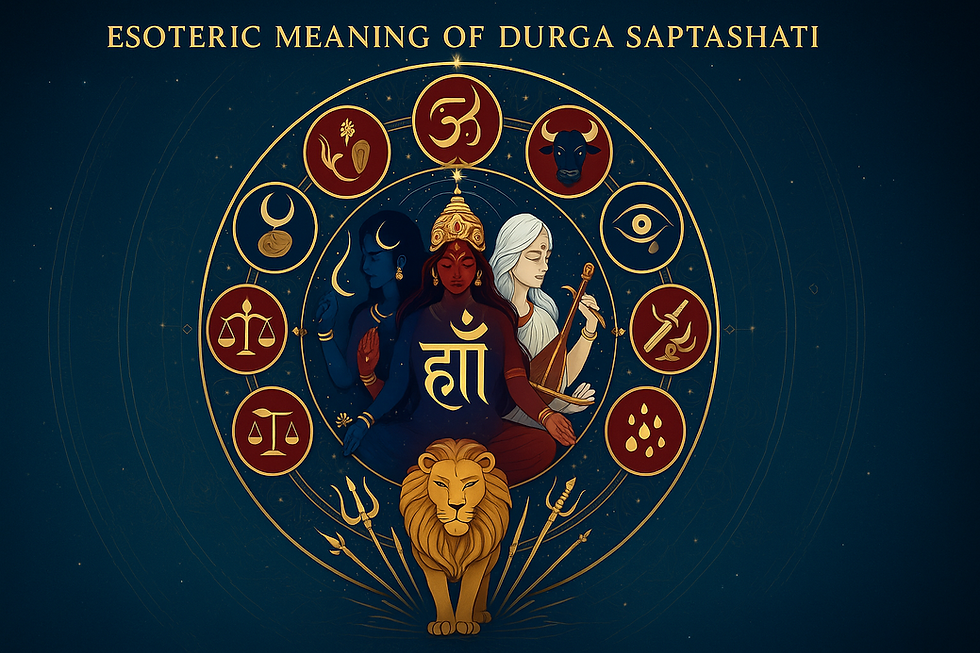Lalitā Sahasranāma as a Hidden Treatise on Anatomy & Physiology
- Dr Ananth Nalabanda
- 20 hours ago
- 4 min read

Where Yogic Mysticism Meets Biomedical Science
One of the most astonishing revelations of the Lalitā Sahasranāma is that behind its devotional poetry lies an extraordinary, systematic description of human anatomy, physiology, embryology, and subtle-energy science. Through the framework of the Ṣaṭ-Chakras and their presiding Yoginīs, the text encodes a complete physiological map of the human body.
As I studied this more deeply—drawing from the profound explanations of Śrī Garikapati Narasimha Rao garu and integrating my own medical background—it became clear that the ancient yogis possessed an advanced understanding of the human body.
The Lalitā Sahasranāma is not only a hymn of devotion; it is also a manual for optimal health, a text whose daily chanting aligns the practitioner with physiological harmony.
The correlations between the Yoginīs, the Dhātus of Ayurveda, and modern endocrine–nervous system physiology are too precise to be dismissed as coincidence.
Chakra → Yoginī → Dhātu → Modern Physiology
A Neuro-Endocrine Blueprint Embedded in a Sacred Hymn
Below is a refined summary integrating these ancient descriptions with contemporary biomedical understanding.
1. Viśuddhi Chakra (Dākinī) — Rasa Dhātu — Thyroid Axis
Textual basis:Namas 475–484 describe Dākinī, presiding over the ārakta-varṇa embryonic phase and governing Rasa Dhātu (plasma/lymph).
Symbolism:Dākinī’s single face may represent the uniformity of skin and surface tissues that belong to the rasa system.
Modern physiological parallel:Viśuddhi aligns with the thyroid gland, responsible for:
basal metabolic rate
protein synthesis
growth and development
Its three major secretions mirror the “three-eyed” symbolism:
T₃ – Triiodothyronine
T₄ – Thyroxine
Calcitonin
The Sahasranāma’s reference to pāyasa (milk-rice) as her favourite offering aligns with the nourishment of Rasa Dhātu and fluid balance.
2. Anāhata Chakra (Rākinī) — Rakta Dhātu — Blood Physiology
Scriptural reference:Namas 485–494 describe Rākinī seated in the heart lotus, ruling Rakta Dhātu (blood).
Modern correlation:Blood has two essential components:
Red blood cells – oxygen transport
White blood cells – immunity
Rākinī’s two faces beautifully correspond to this functional duality.
It may also represent:
oxygenated vs. deoxygenated blood, or
atria vs. ventricles of the heart
Embryologically, this stage aligns with the formation of head structures and hematopoiesis.
Her offering, ghee rice, supports lubrication and circulation—exactly the qualities of Rakta.
3. Maṇipūra Chakra (Lākinī) — Māṃsa Dhātu — Muscle Tissue
Chakra description:Namas 495–503 portray Lākinī as crimson, three-faced, and residing in the region of metabolism and digestion.
Modern physiology:There are three types of muscles:
Skeletal – voluntary movement
Cardiac – heart muscle (connecting Anāhata and Maṇipūra)
Smooth – digestion, vessels
Lākinī’s three faces mirror these three muscle systems.The embryological stages of limb and flesh formation also match this chakra’s chronology.
4. Svādhiṣṭhāna Chakra (Kākinī) — Meda Dhātu — Fat/Adipose Tissue
Scriptural basis:Namas 504–513 describe Kākinī in golden attire, governing Meda Dhātu.
Modern correlation:Fat exists in four key categories:
Saturated fats
Trans fats
Monounsaturated fats
Polyunsaturated fats
These four map seamlessly onto Kākinī’s four faces.
Her offerings—honey and curd rice—support hormonal balance and lipid metabolism, aligning with reproductive and fluid systems associated with Svādhiṣṭhāna.
5. Mūlādhāra (Sākinī) — Asthi Dhātu — Bone System
Textual reference: Namas 514–520 describe Sākinī as five-faced, wearing bone garlands—symbol of Asthi Dhātu.
Modern anatomical correspondence:There are five types of bones:
Long bones
Short bones
Flat bones
Sesamoid bones
Irregular bones
Sākinī’s pañcha-vaktra embodiment mirrors this exact five-fold structure.
Her food, green-gram rice, is vata-balancing and strengthens bones.
The embryological development of the spine aligns with the Mūlādhāra stage.
6. Ājñā Chakra (Hākinī) — Majjā Dhātu — Bone Marrow & Neural Tissue
Scriptural description:Namas 521–527 describe Hākinī, six-faced and luminous, ruling Majjā Dhātu.
Modern physiology:Marrow has six essential components:
Myeloid stem cells
Lymphoid stem cells
Red marrow
Yellow marrow
Reticular network
Stromal cells
Ājñā also represents:
brain
optic pathways
hypothalamic–pituitary axis
Hākinī’s six faces map this perfectly.
Her food—turmeric rice—supports immunity and blood purification.
7. Sahasrāra (Yākinī) — Śukra Dhātu — Reproductive & Consciousness Matrix
The thousand-petalled lotus symbolizes:
pure consciousness
infinite potential
integration of all energies
Śukra Dhātu governs:
fertility
vitality
ojas, the subtle essence of immunity and spirituality
Modern physiology correlates this to:
reproductive cells
endocrine orchestration
neurochemical bliss states
Yākinī’s all-colour radiance parallels the spectrum of genetic and consciousness expression.
A Hidden Biomedical Blueprint in a Spiritual Text
The correspondences are striking:
Chakra | Yoginī | Dhātu | Modern Physiology |
Viśuddhi | Dākinī | Rasa | Thyroid & Lymph |
Anāhata | Rākinī | Rakta | RBC & WBC |
Maṇipūra | Lākinī | Māṃsa | 3 Muscles |
Svādhiṣṭhāna | Kākinī | Meda | 4 Fats |
Mūlādhāra | Sākinī | Asthi | 5 Bone Types |
Ājñā | Hākinī | Majjā | 6 Marrow Types |
Sahasrāra | Yākinī | Śukra | Reproduction |
The sequence—plasma → blood → muscle → fat → bone → marrow → reproductive essence—is the exact progression described in:
foetal development
Ayurvedic dhātu formation
chakra evolution
Yoginī guardianship
bīja mantra ascent
This extraordinary convergence shows that the Lalitā Sahasranāma is far more than a devotional chant.
It is a holistic manual of human physiology, energetic anatomy, and cosmic consciousness, encoded poetically through the Yoginīs and chakras.
Chant the Lalitā Sahasranāma with conscious awareness of your chakras. It has opened doors of healing and awakening in my own life.
May Her grace be with you. Jai Māa. Jai Sai Ram














Comments